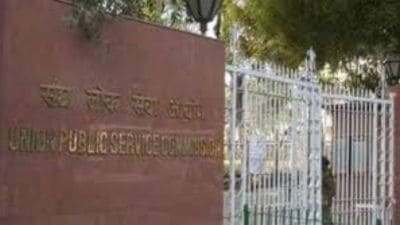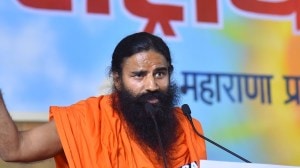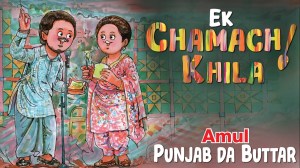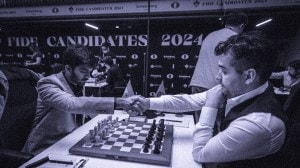- India
- International
Decoding Burhan Wani’s death: As rage gets younger, new hotspots emerge in Valley’s islands of calm
As the most severe crisis Kashmir has faced since 2010 fades from TV screens, many across the country are likely to soon adopt the same attitude.
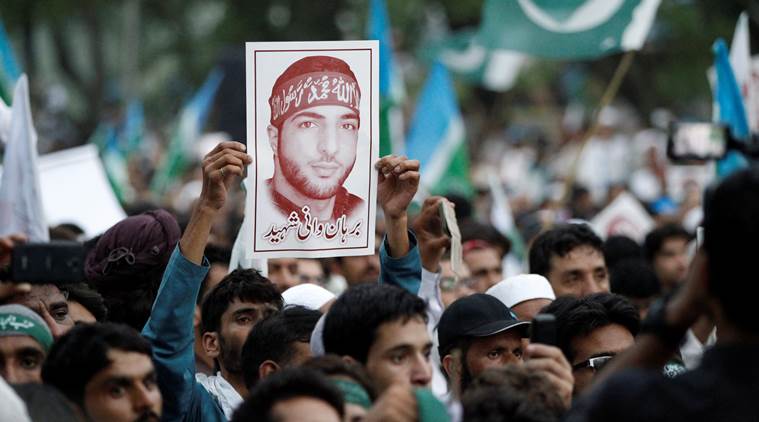 Footage from army drones flown over the funerals of Burhan Wani and Sartaj Sheikh, and accessed by The Indian Express, belies the widespread notion that the violence was sparked by the July 8 killing of both. (Source: File/Reuters)
Footage from army drones flown over the funerals of Burhan Wani and Sartaj Sheikh, and accessed by The Indian Express, belies the widespread notion that the violence was sparked by the July 8 killing of both. (Source: File/Reuters)
“LOCKE, read Locke,” says Sub-Inspector Mudassir Nazar, warily eyeing the group of youngsters hurling stones at him in Anantnag’s Janglaat Mandi.
The passage that Nazar is referring to comes from 17th-century English philosopher John Locke’s ‘Essay Concerning Human Understanding’: “Let us then suppose the mind to be, as we say, white paper void of all characters, without any ideas. How comes it to be furnished? Whence comes it by that vast store which the busy and boundless fancy of man has painted on it?”
Across the street, a teenager pulls down his pants repeatedly, making obscene gestures. “Dabang (fearless), come and get me,” he taunts the Sub-Inspector. But Nazar isn’t biting. His post-graduate education in English literature has, evidently, trained him to absorb uncommon provocation. “I’m going to ignore him, and he will go away,” he says.
As rage gets younger, new hotspots emerge in Valley.
As the most severe crisis Kashmir has faced since 2010 fades from TV screens, many across the country are likely to soon adopt the same attitude. Of over 2,000 people treated for injuries, less than a hundred are still in hospital.
The story, though, doesn’t end there: the most intense clashes and the largest number of fatalities have been seen in regions untouched by street violence in the past. Large parts of south Kashmir are still locked down by barricades strung across rural roads, with groups of young people attacking police, beating government employees and blocking transport.

Footage from army drones flown over the funerals of Burhan Wani and Sartaj Sheikh, and accessed by The Indian Express, belies the widespread notion that the violence was sparked by the July 8 killing of both. The footage shows 12,000-15,000 mourners assembling peacefully — not over 200,000, as claimed in some accounts — with access routes and assembly points carefully guarded by police.
Southern towns like Anantnag, Awantipora, Bijbehara and Pulwama, which saw funeral processions, were mostly calm. Though police clashed with protesters in some places, no fatalities took place: police deployments proved equal to containing the anger.
But elsewhere in south Kashmir that day, things rapidly got out hand, police records show. And, 22 of the 40 people the J&K government lists as killed in the violence were shot by police on July 9 — 8 more were killed on July 10. Verninag, Kokernag, Acchabal, Vailoo, Arwani, Nilow and Nehama — where the first wave of killings began, with mobs targetting small police and military outposts — had seen no violence in 2006, 2008 or 2010, when the rest of Kashmir roiled in crisis.
Ill-prepared for the attacks, the small detachments of police deployed in the region fired when they feared for their lives, or fled. Damal Hanjipora, a small town at the foot of the Pir Panjal mountains, saw mobs torch the local police station. Forty-five weapons were looted from the armoury, two of which, police allege, were later used to open fire on an army vehicle in Kulgam district from amidst a mob.
Elsewhere, small mobs of young people attacked targets they associated with those in power: housing for Kashmiri Pandit government employees outside Anantnag; a small roadside temple in Kokernag; factories and fruit orchards owned by individuals linked to the political élite.
Two years ago, these places set records in participation in the assembly elections. Dooru, where 64.9 per cent of the electorate voted, saw the PDP Farooq Andrabi defeat his Congress rival by just 121 votes, while Kokernag saw the PDP win on the back of a 66.1 per cent turnout.
Watch Video: What’s making news
Kokernag legislator Abdul Rahim Rather, who fled hours before his own hotel was burned down, says: “There are people in our area who are very angry over unemployment, and some young people who were charmed by Burhan Wani. The scale of the rage, though, is incomprehensible.”
Three factors, state intelligence officials say, could explain what happened. First, the small south Kashmir hamlets are also regions with a high presence of terrorists, leading to speculation they may have sparked the protests in remote rural areas.
Local politics might also have had a role. In Shopian, police allege, National Conference cadre targetted the PDP legislator’s home; PDP cadre are alleged to have joined in the violence in Pulwama and Bijbehara, piggy-backing the popular anger.
Finally, there’s the possibility that cadre of the Jama’at-e-Islami, long supportive of the Hizb-ul-Mujahideen, may have organised some of the protests, possibly explaining the violence along the Pulwama-Shopian belt.
The killing ended as suddenly as it began: not one of the areas which saw fatalities on July 9 and July 10 reported subsequent violence. The protests continued, though, but protesters stopped attacks on police and military outposts, bar one on a military patrol on July 18 which led to the loss of three lives.
However, it is clear that the violent politics that began to spread across Kashmir’s cities ten years ago has now begun to put down new rural roots.
Fourteen years old, and already spending his days on the streets instead of in school, the story of one of the teenagers battling Sub-Inspector Nazar helps understand the despair. He’s too young to remember the violence of 2010, when 117 protesters were shot dead — too young, in fact, to be named, according to the law. Mentored by a generation of young men who participated in these battles, though, he’s been one of hundreds of foot-soldiers who sustained the war in the months and years before Burhan Wani was killed.
Little noticed outside Kashmir, the street battles escalated slowly through 2014 and 2015 — often focussed around clashes between security forces and villagers during shootouts with insurgents, or at their burials. This Eid, Chief Minister Mehbooba Mufti’s government attempted to address this youth rage, by withdrawing 104 ongoing prosecutions against 634 men who were charged with throwing stones at police between 2008 and 2014.
“I’m fighting for azadi,” says the teenager. Unmoved by the government’s gesture of conciliation, he adds, “I will continue to fight for it as long as I am alive.” He doesn’t want to become a jihadist like his idol Burhan Wani — “I have four sisters to care for” — but insists he is willing to die.
That’s a possibility each day he fights the police. He could also end up having to be cared for by his sisters. Plastic pellets fired by police, government figures record, caused eye injuries to 166 people — 23 have lost one eye, three have lost both.
The despair in Deva Colony in Anantnag, where the teenager lives, provides context to his death wish. Home mainly to artisans reduced to casual labour by a changing economy, the slum has high levels of youth unemployment. Young men do not have the money to get married; and because of low income levels, drug use is growing. There are no parks or means of leisure for the young people wandering its streets, and almost no prospects of escaping the slum.
Like Deva Colony, old-city trading and artisanal enclaves in Anantnag, Baramulla, Srinagar and Sopore — the main focal points of street violence — were bypassed by development in post-independence Kashmir, since the peasant-focussed National Conference had no interest in the cities. Following the revival of democratic politics in 1995, the secessionist-led cities rejected elections, losing out on any potential gains.
Then, from 2006, young people began drawing on mobile internet to mobilise independently of the secessionist leadership. Figures like Burhan Wani, as well as distant causes like the Islamic State, became motifs of their aspiration. In Islamism, this group found a vocabulary for its rage.
“These young people, they listen to no one,” senior PDP politician Muzaffar Beigh had said in 2010, in the midst of the violence at the time.
Back in Anantnag, Sub-Inspector Nazar sums it up. “Locke teaches us that everyone gets their ideas from somewhere.
The kids throwing stones at me, they weren’t born doing that. It’s what their environment has taught them to do, it’s the only language they have,” he says.
Buzzing Now
Apr 16: Latest News
- 01
- 02
- 03
- 04
- 05











